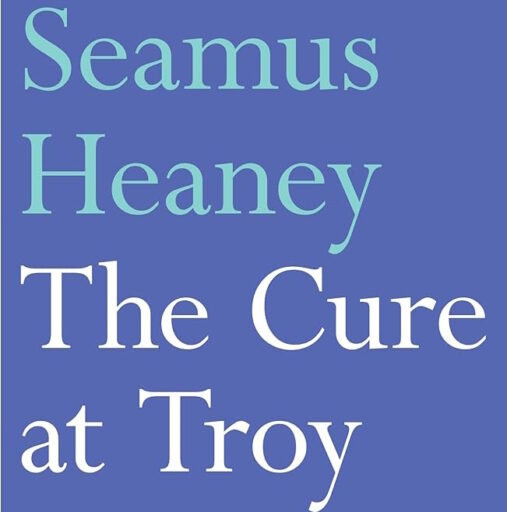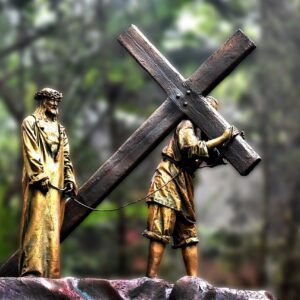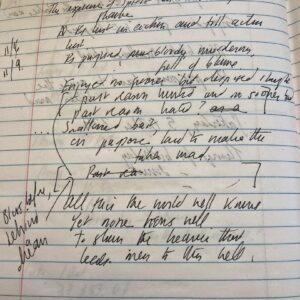My late uncle, my mother’s sister’s husband, was a Palestinian Arab Christian, born and raised in what was then the port of Jaffa, now part of the Israeli city of Tel Aviv. He was studying at the American University of Beirut when what he called the Nakba (“catastrophe”)—the 1948 founding of the state of Israel and the displacement of 700,000 Arab residents—drove his family from their home. Uncle Khamis was a skilled surgeon who rarely talked about that part of his history in my presence, but I grew up in suburban Cincinnati with a very different narrative of the Middle East than most of my peers. To this day, those competing narratives and the questions they raise remain intractably complex, availing no ready solutions.
I know too well the long and poisonous history of antisemitism, culminating in the Holocaust or Shoah—the latter term a Hebrew word for “desolation” and, coincidentally, “catastrophe”—to deny the legitimate aspirations of the Jewish people for a self-governing homeland. I also know of the suffering of Palestinians in the West Bank and Gaza who long for their own state, aspirations whose legitimacy is again obscured by the murderous tactics of Hamas. Many of my Jewish friends draw a sharp distinction between Israel’s right to peaceful existence and the Israeli government’s harsh policies toward Palestinian residents in its occupied territories. That’s a distinction rarely made by conservative American Evangelical Christians, for whom the state of Israel plays an outsized role in contemporary dispensational theology, a nineteenth century reinterpretation of certain biblical texts that sent deep roots throughout American fundamentalist Protestantism.
The full story is messier than that, of course. Stories usually are. I could go on, but this is not an essay about the Middle East, Arabs vs. Jews, or theological novelties. This is an essay about narratives and how we might change them.
My wife and I were on retreat in Belfast when news of Hamas’s vicious assault and Israel’s brutal reprisals reached us. The eight-day immersion in the Irish landscape, culture, and history focused on transcending received narratives of the Troubles in Northern Ireland. In conversation with longtime residents—Protestant and Catholic—we learned how cycles of terror and reprisal between IRA and Loyalist paramilitaries had far more to do with historical injustices, settler colonialism, socioeconomic repression, and fear of the unknown other than disagreements over theology and church governance.
To be sure, there were and are religious bigots in Northern Ireland, but today’s threats to the 1998 Good Friday Peace Accords stem largely from secular blunders like Brexit and a resultant uncertainty over borders. More to the point, we met or heard of ordinary people who, through small acts of bravery made peace possible: the Catholic priest who brought leaders of nationalist factions together in dialogue; the Presbyterian minister who overcame her fear and accepted an invitation to meet with Catholics; lay women working to feed their hungry neighbors not as a charitable end in itself, but as a step toward mutual interdependence; seasoned veterans not of war but of the much harder work of reconciliation and peacebuilding—a service to all humanity for which they are rarely, if ever, thanked.
Among the books I brought to read while on retreat was Marilynn Richtarik’s Getting to Good Friday: Literature and the Peace Process in Northern Ireland, which examines Irish writers who commented on and sought to strengthen peace efforts through poetry, fiction, and drama. Richtarik considers several influential works that treat violence in Northern Ireland obliquely, finding a deeper truth than the sum of daily news reports by telling things “slant.” Much as Stephen Dedalus in James Joyce’s Portrait of the Artist as a Young Man chooses to leave Ireland “to forge in the smithy of my soul the uncreated conscience of my race,” a little distance affords much needed perspective.
A fascinating example of this approach is Seamus Heaney’s The Cure at Troy, his 1990 verse adaptation of Sophocles’ fifth century BCE tragedy, Philoctetes. In Greek legend, Philoctetes possessed the bow of Hercules, a weapon he takes with him on the Greek expedition to Troy. Stopping at an island along the way, however, Philoctetes is bitten in the leg by a snake. The resulting wound grows so foul smelling that his fellow Greeks maroon him on an island, where Philoctetes curses his betrayers. When the Greeks learn they cannot take Troy without the Philoctetes’ help, they dispatch Odysseus to retrieve both archer and bow by any means necessary. Sophocles transforms the received story in which Odysseus deceives Philoctetes, steals his bow, and badgers him into rejoining the Greeks by adding a third character, Achilles’ son, Neoptolemus, who begins to sympathize with Philoctetes’ fate and his bitter resentment toward the Greeks. Neoptolemus’ crisis of conscience—whether to do as ordered by the Greek leaders or, in acknowledging Philoctetes’ legitimate grievances, refuse to deceive him—takes prominence in Sophocles’ retelling. The moral dilemma grows so complex that only through the otherworldly intervention of a deified Hercules does Philoctetes agree to accompany Odysseus back to Troy.
Heaney uses Sophocles’ revisions to comment on the Troubles, stressing how Neoptolemus changes by seeing Philoctetes in his grief and pain rather than as a pawn in a political game. Near the play’s end, Heaney’s chorus speaks of “the innocent in gaols,” “a hunger-striker’s father” standing dumb in a graveyard, and “the police widow in veils” fainting at the funeral home before saying:
History says, Don’t hope
On this side of the grave.
But then, once in a lifetime
The longed-for tidal wave
Of justice can rise up,
And hope and history rhyme.
So hope for a great sea-change
On the far side of revenge.
Believe that a farther shore
Is reachable from here…
Sophocles and Heaney change the traditional narrative, bridging the gap between enemies with empathy and reaching a farther shore where former adversaries might grieve together.
Bernard MacLaverty’s 1997 novel, Grace Notes, follows Catherine, a composer who left Northern Ireland for Scotland to study and distance herself from family. Now seeking to renegotiate relationships with estranged relatives, Catherine returns to Belfast for her father’s funeral. There, Catherine and her mother voice their angers and hurts, acknowledging a shared sense of loss while taking tentative, awkward steps toward reconciliation. In part two of the novel, set months earlier, Catherine emerges from a deep depression, finding solace in writing a new orchestral work that incorporates sonic references to her Catholic upbringing and Protestant marching drums. The story literally ends on a high note, though we know from part one that much labor awaits. No naïve optimist, MacLaverty structures his narrative non-linearly, beckoning toward a resolution that will not come easily, smoothly, or quickly. Yet in making music, Catherine discovers an exhilaration that “…comes from nowhere…Sheer fucking unadulterated joy. Passion and pattern.”
Again, I could go on, though I don’t believe for a moment that music or literature alone will bring peace to the world’s troubled places. Memories are too long, the wounds too deep, and resentments too dear to readily abandon. But small steps can and are taken by those willing to transform received narratives, changing the outcome by changing the story. Where shall we start?
Brian Volck is a pediatrician and writer living in Baltimore. He is the author of a poetry collection, Flesh Becomes Word, and a memoir, Attending Others: A Doctor’s Education in Bodies and Words. His website is Brianvolck.com





